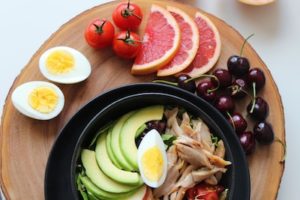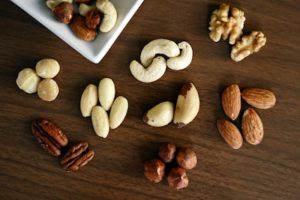 We talk about “Eating Healthy,” “Healthy Food” or certain ingredients being “Healthy,” but has all this talk changed our eating habits? Probably not! The reality is that 80% of consumers in the U.S. aren’t eating enough vegetables, fruit and dairy (despite the campaigns), and consuming too much added sugars, saturated fat and sodium. There are multiple reasons why we, as a nation, are not on a healthy eating track, but not having a clear understanding of what “Healthy” even means can contribute.
We talk about “Eating Healthy,” “Healthy Food” or certain ingredients being “Healthy,” but has all this talk changed our eating habits? Probably not! The reality is that 80% of consumers in the U.S. aren’t eating enough vegetables, fruit and dairy (despite the campaigns), and consuming too much added sugars, saturated fat and sodium. There are multiple reasons why we, as a nation, are not on a healthy eating track, but not having a clear understanding of what “Healthy” even means can contribute.
According to the IFIC 2022 Food and Health Survey, the definition of “Healthy” may be in the eye of the beholder. Since the IFIC survey began, taste and price rule when it comes to the main drivers for purchasing food. Healthfulness is in a strong third place. While some of us may consider a food to be “Healthy” based on “what’s in the food,” others perceive “Healthy” as “what’s not” in a food or its form of production. Since 2016, the Food and Drug Administration (FDA) has solicited comments on how to define the term “Healthy.” Finally, on the eve of the White House Conference on Hunger, Food and Nutrition, the long-awaited proposed definition was released. Is the issue resolved? No, not immediately … but guidelines now exist to help identify “Healthy” food that is really “Healthy.”
Resolving the Confusion
Over the past six years, surveys and submitted public comments show conflicting perceptions about what makes food “Healthy.” In previous IFIC surveys, the lack of GMOs, artificial ingredients, unprocessed, as well as fresh and natural, rose to the top when survey respondents were asked to define the term. In the 2022 edition, the most frequent responses were similar with more emphasis on the positive contributions. Over a third of the consumers surveyed identified “fresh” or “low in sugar” as “Healthy” attributions. Other frequent responses (approximately 30%) defined “Healthy” as:
- a “good source of protein”
- “contains fruits or vegetables (or includes these ingredients)”
- “good source of nutrients” and
- “natural” 1
The proposed rule does call out the benefits of food groups and limit those ingredients (sugar and sodium) that are linked to health risks — making it easier for consumers to make the healthier choice when choosing packaged food.
Changing Course for Clarity
 The original “Healthy “definition in the 90s focused mainly on the total fat content of a product. It may have seemed logical, but the narrow view eliminated naturally occurring healthful foods like nuts or seeds. In 2015, KIND contested the definition when FDA requested the company remove the “Healthy” claim from its label due to the fat content — fat that came from the nuts in the bars. FDA reversed its decision in 2016 and opened the door for public comments to relook at the criteria for “Healthy.”
The original “Healthy “definition in the 90s focused mainly on the total fat content of a product. It may have seemed logical, but the narrow view eliminated naturally occurring healthful foods like nuts or seeds. In 2015, KIND contested the definition when FDA requested the company remove the “Healthy” claim from its label due to the fat content — fat that came from the nuts in the bars. FDA reversed its decision in 2016 and opened the door for public comments to relook at the criteria for “Healthy.”
Now, the proposed definition takes a more holistic approach, looking at the overall nutrient value and health benefits of food groups and meal patterns based on the U.S. Dietary Guidelines for Americans 2020-2025. Food items, like whole fruits and vegetables are inherently “Healthy.” Food items with lower fat content like skim and fat-free milk, or naturally occurring healthful fats in eggs, nuts and seeds, and higher fatty fish (e.g., salmon), avocados, water and certain oils can be labeled as “Healthy.”
For a packaged product to be labeled “Healthy,” the proposed requirements are more complex. There must be a significant amount of food from at least one food group (fruit, vegetable, dairy or grain) as per the U.S. Dietary Guidelines for Americans and a limited amount of saturated fat, sodium and added sugars. The amounts of sodium and saturated fats have been significantly reduced from the current threshold levels to bear a “Healthy” claim. For example, 480 mg sodium is the maximum level per serving now to bear the claim. The proposed maximum level is 10% of the Daily Value (DV) or 230 mg per serving. For saturated fat, the proposed maximum level is 5% of DV or <1 gm per serving. The exception is 10% of DV for dairy, meat and eggs and 20% for certain oils and spreads. Also, higher levels of sodium and saturated fat are allowed for main dishes and meal products. Note that coconut oil would not be considered “Healthy” due to its saturated fat content. The FDA is proposing a maximum level of added sugars in a food at 5% of DV (50 g) or less than 2.5 g per serving. FDA did state individual products variations may be considered. For example, a “Healthy” packaged product (as cited in the FDA press release), shows a serving of “Healthy” cereal would include ¾ ounces of whole grains and have no more than 1 gram of saturated fat, 230 milligrams of sodium and 2.5 grams of added sugars. Finally, FDA is proposing to eliminate the current requirements for total fat and cholesterol in a food to bear a “Healthy” claim.
Exceptions to the Rule

In addition to dairy, other foods complexities like the fat content of eggs or whether the inclusion of fruit and vegetable powder can be counted as food group equivalents are issues being evaluated. FDA is still considering comments before a final rule is made.
What’s Next
FDA is currently evaluating the use of a “Healthy” front of package symbol to make it easier for consumers to make healthier choices. Once the FDA proposed rule is finalized, the chatter will escalate on package symbols. The good news though is that the rule is moving in the right direction — focusing on whole foods and evaluating the reduction of those ingredients tied with health risks. However, the nutrient package of the total food needs to be considered before a “label” is applied.
Bringing clarity for consumers on what is “Healthy” is the first step in helping all of us to make better food choices. Our health depends on it.
References:
1. Paipongna, M. “What’s Next 2022 Food and Health Survey Spotlight: What Is a Healthy Food?” Food Insight, September 14, 2022. Accessed October 2, 2022.
2. Scimeca, J. “Proposed Healthy Rule Embraces Dairy as Part of a Healthy Diet but Relies on Weak Arguments to Exclude Healthy Dairy at all Fat Levels,” International Dairy Foods Association, September 28, 2022. Accessed October 2, 2022.
Resources:
- “Healthy gets a new definition from FDA,” by Megan Poinski, Food Dive, September 28, 2022.
- “What is ‘healthy’? FDA proposes new definition as added sugar, not fat, becomes nutritional bogeyman,” by Elaine Watson, Food Navigator, September 28, 2022.
